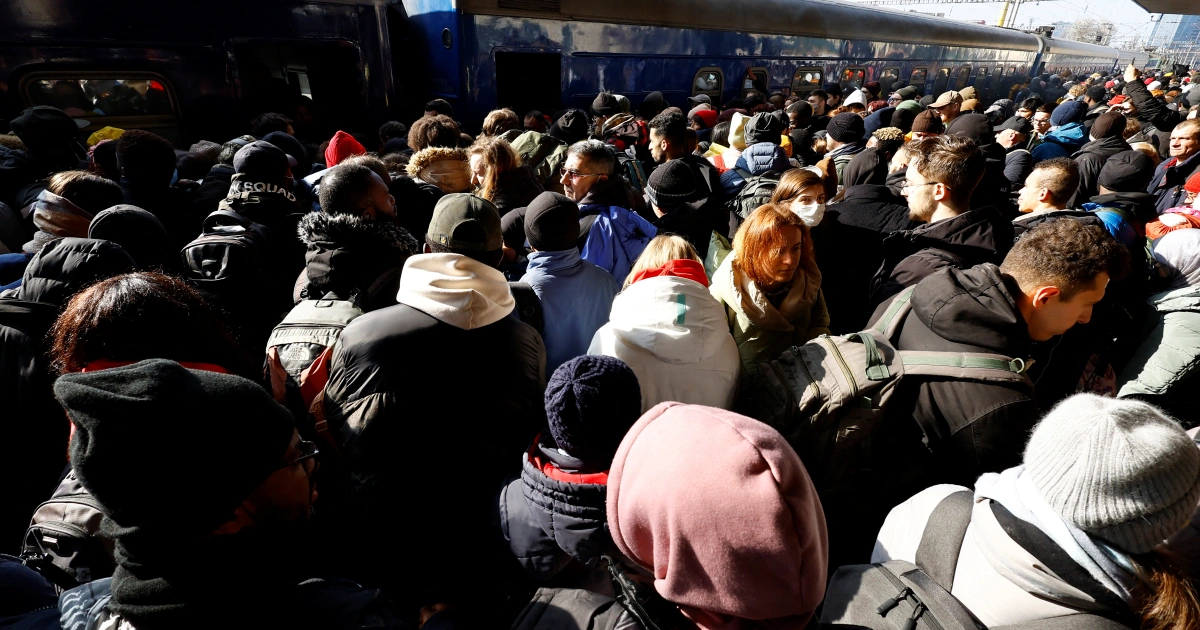Black children caught in the Russian-Ukraine war

By Shade Momoh
The past eight years of conflict in eastern Ukraine has inflicted profound and lasting damage to children on both sides of the line of contact.
Now, the suffering extends across the country. Hundreds of thousands are without safe water, electricity or water due to damage to infrastructure.
Many Nigerian students, mostly children, are caught in the Russia-Ukraine war. One of them, Lolade Lawal’s life has been turned upside down in a way she never imagined.
The third-year medical student from Nigeria is coming to terms with the effects of Russia’s invasion of Ukraine that started last week.
“It is scary, very scary. I’m very worried. People are running for their lives. We are hiding in groups so we can keep an eye on each other,” Lawal told Al Jazeera over the phone as she sheltered with other students at a safe bunker in the northeastern city of Sumy.
“At my university, there are about 100 Nigerian students. I’m sheltering with some of them,” Lawal added.
Russian President Vladimir Putin ordered what he said was a “special military operation” against Ukraine on Thursday. A full-scale invasion followed, with Ukrainian President Volodymyr Zelenskyy declaring martial law, saying his country would defend itself.
Fighting already reached the streets of Ukraine’s capital Kyiv as Russian troops pressed ahead.
According to the US military, Russia now has at least 50 percent of its estimated 150,000-strong invasion forces in Ukraine.
The conflict has so far killed more than 200 civilians, including three children. Nearly 1,100 have been injured in the conflict, including 33 children, according to Ukraine’s health ministry.
The United Nations estimates more than 100,000 people have been displaced within the country since the conflict started.
There’s no escape. Trains have stopped working. Most supermarkets are closed and those that are opened are running very low on food stocks. ATMs are not working and everyone is desperately looking for money.
There are no official figures on the number of African students currently studying in Ukraine but there are hundreds of them all scattered around the country. Some students have managed to cross the border into Poland.
“I live in Kyiv. I have been living here since March last year,” Somto Orah, a student at State University of Telecommunications in Kyiv, told Al Jazeera.
“We have received no support from any government authorities. The school only gave us bomb shelter to hide when the air raid siren is on. The sirens came on and off for about five times yesterday before I left,” Orah, a Nigerian national, added.
“There is little food. I couldn’t access cash for two days now. Every ATM on the road has no cash.”
Others have had even less luck.
Samuel George, a first-year software engineering student, fled Kyiv after the shelling and sirens got too much for him to handle.
“I drove from Kyiv. We are trying to survive. We don’t want to die in a foreign country,” George said.
As he neared the Polish border, Samuel’s luck ran out. He said he had a minor road accident with a vehicle carrying Ukrainians because the road was narrow.
He said they took his money and stopped him from driving any further.
“They are not officials, police or military. They are normal citizens who stopped us Africans from driving to the border. They let Ukrainians pass through but not us,” George said.
“I’m now walking to the border. I have no other option. I don’t know how much further the border is. They even took our money. It is like they are not human beings,” George said, adding that he could no longer talk on the phone because his hands were freezing in the sub-zero temperature.
The Polish Ministry of Internal Affairs said more than 115,000 people had crossed into Poland from Ukraine, adding that everyone from Ukraine was allowed to enter, even those without a valid passport.
But for Somto and several other black students, crossing the border into Poland has not been easy.
“I will be heading to Nigeria from Poland if I’m able to cross. But if I see a school offer around Schengen, I will take it up because I don’t want my school life to be disrupted,” he said as he joined the queue at the border gate.
The African countries with the most students in Ukraine are Morocco (8,000), Nigeria (4,000) and Egypt (3,500). They constituted – as the pan-African publication Quartz points out – almost 20% of all foreign students studying in Ukraine in 2020.
Nigeria’s Ministry of Foreign Affairs said it had “received with surprise” news of Russia’s incursion, and measures were being taken to keep its nationals in Ukraine safe and to “facilitate the evacuation of those who wish to leave” as soon as airports re-opened.
A Nigerian medical student in Ukraine, Fatima Halilu, told the BBC that she left Kyiv nearly two weeks ago.
“All my friends are still in Kyiv. They seem stranded, lost and confused,” she said.
Armed conflict will no doubt result in human suffering and destruction, the effects of which will not only affect Ukraine but also reverberate across the world. No country is immune to the effects of this conflict.
South Africa’s position was a blow to Russia, which sees it as a key ally in Africa. The two countries have strong economic ties, with both being members of Brics – a grouping made up of the world’s emerging economies.
Meanwhile, the UN Children’s Fund, UNICEF, is working to scale up life-saving support for children and their families.
Escalating conflict in Ukraine poses an immediate and growing threat to the lives and well-being of the country’s 7.5 million children. Humanitarian needs are multiplying – and spreading by the hour. Children have been killed. Children have been wounded. They are being profoundly traumatized by the violence all around them. Hundreds of thousands of people are on the move, and family members are becoming separated from their loved ones. UNICEF is working to scale up humanitarian delivery in the east and expanding across the country as needed. This includes:
Ramping up efforts to meet critical and escalating needs for safe water, healthcare, education and protection.
Repositioning health, hygiene and emergency education supplies as close as possible to communities near the line of contact.
Working with municipalities to ensure that there is immediate help for children and families in need.
Supporting mobile teams providing psychosocial care to children traumatized by the chronic insecurity. Currently, UNICEF has 10 mobile teams operating in the east. These child protection case management mobile teams respond to violence, abuse, separation from family, gender-based violence, mental health and disability cases.
Continuing emergency response efforts to address the COVID-19 outbreak, including by working with municipalities to increase COVID-19 vaccination rates, and by strengthening awareness raising and capacity building efforts.
As hostilities in Ukraine escalate, children may see and hear things about the crisis in the news, leading to feelings of uncertainty, anxiety and fear, which parents and caregivers need to address, Save the Children’s psychologists warn.
Ane Lemche, a psychologist and child counsellor with Save the Children, said children around the world might not fully understand what is happening in Ukraine and may have questions about the images, stories, and conversations they are exposed to.
Previous Save the Children research in conflicts such as Iraq and Syria has revealed heartbreaking accounts of children terrified by the shelling and airstrikes, anxious about the future, and distraught at not being able to go to school. The majority of children showed signs of severe emotional distress.
“What is happening in Ukraine can be frightening for both children and adults. Ignoring or avoiding the topic can lead to children feeling lost, alone and more scared, which can affect their health and wellbeing. It is essential to have open and honest conversations with children to help them process what is happening,” said Ms. Lemche.
Experts at Save the Children share five tools and tips that caregivers can use to approach the conversation with children:
Make time and listen when your child wants to talk
Give children the space to tell you what they know, how they feel and to ask you questions. They may have formed a completely different picture of the situation than you have. Take the time to listen to what they think, and what they have seen or heard.
Be mindful of the child’s age as you approach the conversation with them. Young children may not understand what conflict or war means and require an age-appropriate explanation. Be careful not to over-explain the situation or go into too much detail as this can make children unnecessarily anxious. Younger children may be satisfied just by understanding that sometimes countries fight. Older children are more likely to understand what war means but may still benefit from talking with you about the situation. In fact, older children will often be more concerned by talk of war because they tend to understand the dangers better than younger children do.
Validate their feelings. It is important that children feel supported in the conversation. They should not feel judged or have their concerns dismissed. When children have the chance to have an open and honest conversation about things upsetting them, it can create a sense of relief and safety.
Reassure them that adults all over the world are working hard to resolve this.
Remind children that this is not their problem to solve. They should not feel guilty about playing, seeing their friends, and doing the things that make them happy. Stay calm when you approach the conversation. Children often copy the sentiments of their caregivers – if you are uneasy about the situation, chances are your child will be uneasy as well.
Support children who want to help. Children who have the opportunity to help those affected by the conflict can feel like they are part of the solution. Children can create fundraisers, send letters to local decision-makers or create drawings calling for peace.
Save the Children has been operating in Ukraine since 2014, delivering essential humanitarian aid to children and their families. This includes supporting access to education, distributing winter kits and hygiene kits, and providing cash grants to families. Their specialists support children to overcome the mental and psychological impacts of their experiences of conflict and violence and increase their ability to cope with stress in their daily lives.
Attacks on kindergartens and schools have been a sad reality for children in eastern Ukraine over the last eight years, UNICEF, said. Since the beginning of the conflict, more than 750 schools have been damaged.
According to media reports and the Ukrainian Government, shells fired by separatists in the east, hit and damaged a kindergarten in the Luhansk region. There were no reported casualties.
Attacks on kindergartens and schools have been a sad reality for children in eastern Ukraine over the past eight years.
In a statement, the UN agency said that attacks on schools – since fighting began in the eastern region between Government forces and mostly pro-Russian separatists in 2014 – have been disrupting access to education for thousands of children on both sides of the contact line.
Furthermore, the agency said children in eastern Ukraine live in one of the world’s most mine-contaminated stretches of land. “Every day, they live, play, and go to and from school in areas littered with landmines, unexploded ordnances, and other deadly explosive remnants of war”.
The conflict has taken a severe toll on the psychosocial well-being of an entire generation of children, there is the need for all parties to protect children and their caregivers from attacks.
All parties should respect the Safe School Declaration, protection must be provided to keep children and their caregivers safe, regardless of the circumstances they might find themselves in.
According to recent data, for children living in conflict, education has become even more dangerous. In 2020, there were 535 verified attacks on schools, an increase of 17 per cent compared to 2019.
The Safe Schools Declaration which opened for State endorsement in Oslo, Norway, in May 2015, is a commitment to better protect students, teachers, schools and universities during armed conflict, to support the continuation of education during war, and to put in place concrete measures to deter the military use of schools.
To date, 111 States have endorsed the Safe Schools Declaration. Ukraine did so in November 2019.
READ ALSO: APC crisis: 13 Governors set to leave party, insist on…
“Educational facilities should remain a safe space where children can be protected from threats and crises and a haven where they can learn, play, and grow to their full potential”, the statement reiterated. “A child’s right to education cannot be safeguarded in conflict settings without education itself being protected”, UNICEF underlined.
Since the onset of the conflict, the UN agency has been on the ground across eastern Ukraine, delivering psychosocial support and mine risk education to over 180,000 children, youth, and caregivers.
UNICEF is also supporting repairs to damaged schools and kindergartens and distributing vital classroom supplies such as educational kits, furniture sets and sports equipment.






